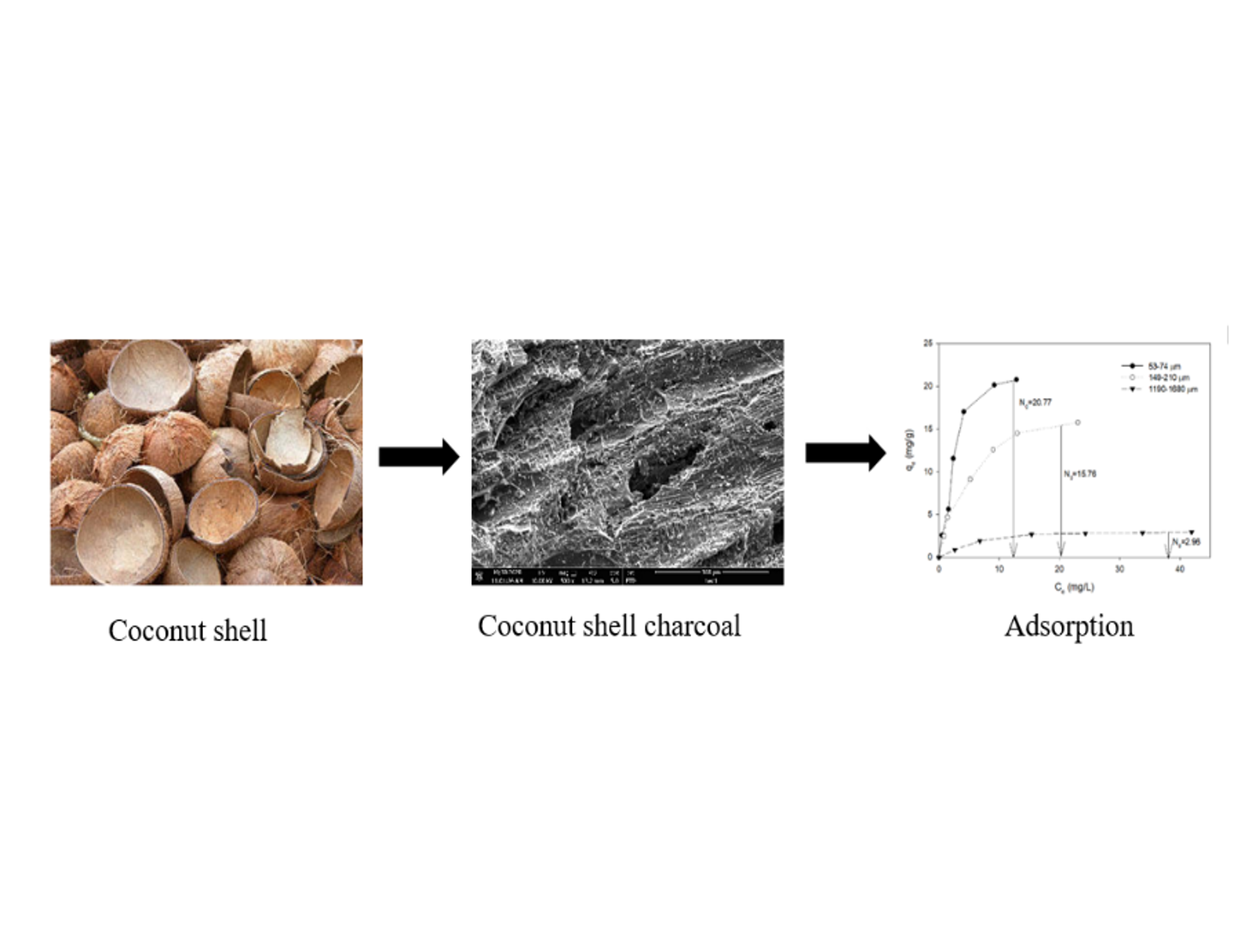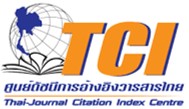Adsorption of methylene blue and ferrous metal solution by using coconut shell charcoal
DOI:
https://doi.org/10.55674/jmsae.v12i2.248672Keywords:
Adsorption, Coconut shell charcoal, Methylene blue, Ferrous metal solutionAbstract
This research was developed based on the problem of waste from the coconut export industry and the current trend of water pollution. This research aims to study methylene blue adsorption by using coconut shell charcoal prepared from clay kilns. The study of adsorption isotherms in batch experiments showed that the coconut shell charcoal was fitted well with Langmuir adsorption isotherms with a capacity of 36.49 mg g–1 for particle size in the range of 53 – 74 mm. Through the determination of the surface area of methylene blue adsorption, coconut shell charcoal in the range of 53 – 74 micrometers had the highest surface area of 65.95 m2 g–1. Coconut shell charcoal was used to study the adsorption of ferrous metal solution at the initial concentration of 15 mg l–1. It was found that 0.25 g of coconut shell charcoal had the highest absorption capacity of 17.29% of the ferrous metal solution.
References
W. Wang, Y.Y. Liu, X.F. Chen, S.X. Song, Facile synthesis of NaOH-modified fishbone charcoal (FBC) with remarkable adsorption towards methylene blue, Procedia Eng. 211 (2018) 495 – 505.
N. Goyal, S. Barman, V.K. Bulasara, Efficient removal of bisphenol S from aqueous solution by synthesized nano-zeolite secony mobil-5, Microporous Mesoporous Mater. 259 (2018) 184–194.
I. Arberas-Jiménez, I. Sifaoui, M. Reyes-Batlle, A. Rizo-Liendo, L. Sancho, A. Urruticoechea, J.E. Piñero, J. Lorenxo-Morales, Ultraviolet – Chlorine combined treatment efficiency to eliminate Naegleria fowleri in artificial surf lagoons, Heliyon. 8(11) (2022) e11625.
A. Asadi, R. Akbarzadeh, A. Eslami, T.-C. Jen, P. Ozaveshe Oviroh, Effect of synthesis method on NS-TiO2 photocatalytic performance, Energy Procedia. 158 (2019) 4542 – 4547.
M.F.M. Yusop, M.A. Ahmad, N.A. Rosli, M.E.A. Manaf, Adsorption of cationic methylene blue dye using microwave-assisted activated carbon derived from acacia wood: Optimization and batch studies, Arab. J. Chem. 14(6) (2021) 103122.
A.C. Lua, A comparative study of the pore characteristics and phenol adsorption performance of activated carbons prepared from oil-palm shell wastes by steam and combined steam-chemical activation, Green Chem. Eng. 8(1) (2022) 69 – 781.
L. Baloo, M.H. Isa, N.B. Sapari, A.H. Jagaba, L.J. Wei, S. Yavari, R. Razali, R. Vasu, Adsorptive removal of methylene blue and acid orange 10 dyes from aqueous solutions using oil palm wastes-derived activated carbons, Alex. Eng. J. 60(6) (2021)
– 5629.
R. Zakaria, N.A. Jamalluddin, M.Z. Abu Bakar, Effect of impregnation ratio and activation temperature on the yield and adsorption performance of mangrove based activated carbon for methylene blue removal, Results in Materials. 10 (2021) 100183.
S.O. Apori, J. Byalebeka, M. Murongo, J. Ssekandi, G.L. Noel, Effect of co-applied corncob biochar with farmyard manure and NPK fertilizer on tropical soil, Resour. Environ. Sustainability. 5 (2021) 100034.
W. Widiyastuti, M. Fahrudin Rois, N.M.I.P. Suari, H. Setyawan, Activated carbon nanofibers derived from coconut shell charcoal for dye removal application, Adv Powder Technol. 31(8) (2020) 3267 – 3273.
C. Bouyahia, M. Rahmani, M. Bensemlali, S. El Hajjaji, M. Slaoui, I. Bencheikh, K. Azoulay, N. Labjar, Influence of extraction techniques on the adsorption capacity of methylene blue on sawdust: Optimization by full factorial design, Mater. Sci. Energy Technol. 6 (2023) 114 – 123.
L. Chen, C. Batchelor-McAuley, B. Rasche, C. Johnston, N. Hindle, R.G. Compton, Surface area measurements of graphene and graphene oxide samples: Dopamine adsorption as a complement or alternative to methylene blue?, Appl. Mater. Today. 18 (2020) 100506.
A. Albalasmeh, M.A. Gharaibeh, O. Mohawesh, M. Alajlouni, M. Quzaih, M. Masad, A. El Hanandeh, Characterization and Artificial Neural Networks Modelling of methylene blue adsorption of biochar derived from agricultural residues: Effect of biomass type, pyrolysis temperature, particle size, J. Saudi Chem. Soc. 24(11) (2020) 811 – 823.
G. Ketsela, Z. Animen, A. Talema, Adsorption of lead (II), cobalt (II) and iron (II) from aqueous solution by activated carbon prepared from white lupine (GIBITO) HSUK, J. Thermodyn. Catal. 11(2) (2020) 203.
S.T. Nipa, N.R. Shefa, S. Parvin, M.A. Khatun, M.J. Alam, S. Chowdhury, S.M.A.Z. Shawon, B.K. Biswas, M.W. Rahman, Adsorption of methylene blue on papaya bark fiber: Equilibrium, isotherm and kinetic perspectives, Results Eng. 17 (2023) 100857.
M. Kumar, S. Sharma, R. Pal, B. Vidhani, Supreet, A novel gas sensor based on activated charcoal and polyaniline composites for selective sensing of methanol vapors, Sensor Actuator Phys, 353 (2023) 114210.
A.S. Yusuff, M.A. Lala, K.A. Thompson-Yusuff, E.O. Babatunde, ZnCl2-modified eucalyptus bark biochar as adsorbent: preparation, characterization and its application in adsorption of Cr(VI) from aqueous solutions, S. Afr. J. Chem. Eng. 42 (2022) 138 – 145.
O. Ifguis, Y. Ziat, F. Ammou, R. Bouhdadi, M. Mbarki, M. Benchagra, Theorithecal and experimental study on the thermodynamic parameters and adsorption of methylene blue on “Argania shells” in industrial waters, S. Afr. J. Chem. Eng. 41 (2022) 211 – 222.
X.-J. Liu, M.-F. Li, S. Singh, Manganese-modified lignin biochar as adsorbent for removal of methylene blue, J. Mater. Res. Technol. 12 (2021) 1434–1445.
F. Fahni, N.A.A. Dewayanti, W. Widiyastuti, H. Setyawan, Preparation of porous graphene-like material from coconut shell charcoals for supercapacitors, Cogent Eng. 7(1) (2020) 1748962.

Downloads
Published
How to Cite
Issue
Section
License
Copyright (c) 2023 Journal of Materials Science and Applied Energy

This work is licensed under a Creative Commons Attribution-NonCommercial-NoDerivatives 4.0 International License.







